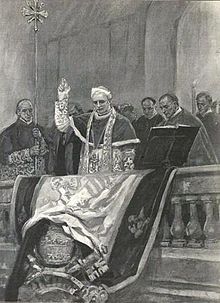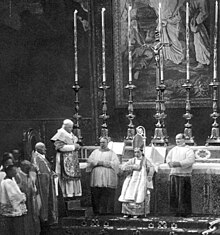Pius X
Pius X (in Latin, Pius PP. X), secular name Giuseppe Melchiorre Sarto (Riese, June 2, 1835-Rome, August 20, 1914) was number 257.o papa of the Catholic Church from August 4, 1903 until his death in 1914.
He is best remembered for his strong opposition to theological modernism and for leading the first codification of canon law in the history of the Catholic Church, which was published in 1917.
Biography
Origins
Giuseppe Melchiorre Sarto was the second of ten children born to Giovanni Battista Sarto (1792-1852) —postman by profession— and Margarita Sansoni, seamstress (1813-1894).
Born June 2, 1835, he was baptized the next day because, though humble, his parents valued instruction.
Previous studies and activities
He completed his primary studies at the school in his hometown, receiving his first Latin lessons from his parish priest. In 1846 he began secondary education at the Liceo Classico of Castelfranco Veneto. On September 20, 1850, he was tonsured by the Bishop of Treviso, who granted him a scholarship that same year to enter the seminary in Padua.
On December 22, 1851 and June 6, 1857, he received minor orders; on September 19, 1857, the subdiaconate; on February 27, 1858, the diaconate. On September 18 of this same year he was ordained a priest in Castelfranco Veneto by Giovanni Antonio Farina, Bishop of Treviso. He was parish priest of Tombolo, Treviso, until 1867, when he was appointed Archpriest of Salzano and Canon of Treviso Cathedral. From 1875 he was rector of the conciliar seminary of this city, and in 1879 he was appointed spiritual director of the same and also chancellor of the Trevisan episcopal curia, prosynodal examiner and capitular vicar.
Episcopacy
On November 10, 1884, Pope Leo XIII appointed him Bishop of Mantua and ten days later, he was consecrated by Cardinal Parocchi, Vicar General of Rome.
In 1891, Pope Leo XIII named him "assistant to the pontifical throne."
Cardinalate
In the Consistory of June 12, 1893, he was created cardinal presbyter of the title of San Bernardo en las Termas. Three days later, he was promoted to Patriarch of Venice; once appointed, the inauguration was delayed since the Italian Government, which had the right to propose the patriarch, did not approve this designation, having to wait sixteen months to make effective the inauguration of his seat in the Patriarchate of Venice.
Papal election
The conclave gathered on the death of Leo XIII lasted four days and seven votes were needed to reach an agreement. Cardinal Sarto was elected pope on August 4, 1903 by 50 votes to 10, out of a total of 62 cardinal electors. Two days before Jan Puzyna of Kosielsko, cardinal of the title of Ss. Vitale, Gervasio e Protasio and Prince-Archbishop of Krakow, had presented in the conclave the veto of Franz Joseph I, Emperor of Austria-Hungary, to the election of Mariano Rampolla del Tindaro, Cardinal of the Title of Santa Cecilia who had been Secretary of State of Leo XIII and who enjoyed the preferences of those gathered. There were timid protests from the majority of the conclave for this interference and Cardinal Rampolla refused to withdraw his candidacy, although he would progressively lose votes in favor of Sarto. Pius X was crowned pope on August 9 in Saint Peter's Basilica for Cardinal Luigi Macchi, Cardinal Protodeacon of Santa Maria in Via Lata.
Papacy
He ruled the Catholic Church with a firm hand at a time when it was confronted with strong secularism as well as numerous modernist tendencies in the fields of biblical studies and theology. The new pope was wary of progressive tendencies and he consciously departed from the more open line followed by his predecessor. Pius X believed a reaction was necessary, adopting from the beginning an attitude of withdrawal and "Catholic defense"; This led him to claim full independence for the Church from civil power, and to openly mistrust Christian democracy.
He introduced some reforms in the liturgy. He allowed the practice of frequent communion and encouraged children's access to the Eucharist. He greatly promoted the study of catechism and entrusted the canonist Pietro Gasparri with the preparation of the Code of Canon Law ( Codex Iuris Canonici ) to gather and unify ecclesiastical legislation, hitherto dispersed.
On January 20, 1904, he had promulgated the apostolic constitution Commissum Nobis which prohibited vetoes of the papal election by states that had him as a historical privilege. In that same year he had relativized the Non Expedit of Pius IX, thereby opening the door to the participation of Italian Catholics in the public affairs of their country.
In 1905 he denounced the Concordat that, under the draconian conditions imposed by Napoleon, had been signed in 1801 by the Holy See with France. With this denunciation, the papacy achieved total freedom to appoint bishops in France, a freedom which, despite the various regimes that had followed one another in this country, it had never really enjoyed.
In July 1908, the reorganization of the Roman Curia culminated with the appearance of three decrees through which the attributions of the Roman congregations were modified and systematized in a more rational way, thus adapting the ecclesiastical administration to the tasks that came with it a steadily increasing centralization since the mid-19th century.
His relationship with the Eastern Orthodox and Catholic churches, marked by the lack of preparation of the pontiff and his new collaborators in this regard, has been described as a "transition period". The papal decree Tradita ab antiquis of September 14, 1912 —which allowed Eastern Catholics to attend services according to Latin rites— materialized the setback of the orientalizing and unionist interest of his predecessor Leo XIII, resumed later by his successor Benedict XV.
Death
Pius X died in the Apostolic Palace in Rome on August 20, 1914, at the age of 79, due to an acute myocardial infarction.
Coincidentally, the same day of his death occurred that of the 25th Superior General of the Society of Jesus, Franz Xaver Wernz.
He was buried in the Vatican grottoes, where his remains remained until, in 1951, they were transferred to the altar of the Chapel of the Presentation of the Vatican basilica, where they are exposed to the veneration of the faithful. His epitaph reads: His tiara was made up of three crowns: poverty, humility and goodness .
Beatification and canonization
Pius X was beatified on June 3, 1951, and canonized on September 3, 1954, both times by Pope Pius XII.
On May 19, 1944, the mortal remains of Pius X were exhumed and exposed for public veneration in the Chapel of the Holy Cross of Saint Peter's Basilica. Canon recognition resulted in his state of complete incorruption, thirty years after his death and although the Supreme Pontiff had expressed his wish that they not be subjected to embalming processes. Cardinals Alfredo Ottaviani and Nicola Canali witnessed this fact.
Documents
Encyclicals
- E Supremiexposes the motto of his pontificate: install all things in Christ (4 October 1903)
- Ad diem illum laetissimumcommemoration of the fiftieth anniversary of the proclamation of the dogma of the Immaculate Conception by Blessed Pius IX (2 February 1904)
- Iucunda sanecommemoration of the 13th centenary of Pope Gregory I the Great (12 March 1904)
- Acerbo nimison the teaching of the Christian doctrine (15 April 1905)
- Il fermo proposito, institution and development of the "Catholic Action" in Italy (11 June 1905)
- Vehementer Nosthe French people, for the situation of Catholicism in their country (11 February 1906)
- Circiter tribescondemnation of the pseudo-order of the "Mariavitas" in Poland (5 April 1906)
- Pieni l'animoon the situation of clergy in Italy (28 July 1906)
- Gravissimo officii munere on Catholic associations in France (10 August 1906)
- Une fois encoreon the situation of the Catholic Church in France (6 January 1907)
- Pascendi Dominici gregisagainst the errors of Modernism (8 September 1907)
- Communium rerumon Saint Anselmo of Aosta (21 April 1909)
- Editae saepeon St. Charles Borromeo (May 26, 1910)
- Notre charge apostoliqueagainst 'Le Sillon' movement of Marc Sangnier (August 10, 1910)
- Iamdudumon the "Separation Law" of Portugal May 24, 1911)
- Lacrimabili statuon the situation of indigenous people in South America (7 June 1912)
- Singulari quadamon workers’ union organizations (24 September 1912)
Apostolic Constitutions
- Commissum nobisby which the right of papal election is reserved to the Sacred College of Cardinals without interference from external powers (20 January 1904).
Apostolic Exhortations
- Haerent animoaddressed to the Catholic clergy on the occasion of the 50 years of priesthood of the Pope (4 August 1908).
On my own initiative
- Tra le sollecitudinion sacred music (November 22, 1903).
- Sacrorum antistitum, an anti-modernist oath (1 September 1910) that was to be pronounced by clerics and theology professors.
In popular culture
Pope Pius X was played by actor Enrico Vidon in the film Gli uomini non guardano il cielo (Men do not look at the sky) in a film that portrays a large part of his life, his election and ascension to the pontifical throne, his ideas during this and finally his death, which took place in the midst of his great concern for the War that would begin just a few weeks after his death. The last loop of the film shows his ancient tomb before his exhumation and transfer to St. Peter's Basilica, where he is exposed for veneration.
Contenido relacionado
Anglicanism
Rudolph Diesel
Larry Sanger










